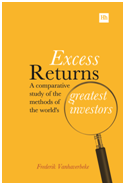May
2022
Classic Investment Mistakes and how to Avoid Them – Part 3
DIY Investor
20 May 2022
Two More Common Buying and Selling Mistakes Among Investors
By Frederik Vanhaverbeke
In my book Excess Returns: A Comparative Study of the Methods of the World’s Greatest Investors, I explain how the world’s most successful investors set about beating the stock market and how they try to avoid the errors that other investors make.
Mistake 4: Refusing to sell poorly performing shares below the purchase price
Peter Lynch, one of the most successful fund managers ever, who achieved an average annual return of 29% between 1977 and 1992, believes it’s wrong not only to sell winning shares but also to hold on to losing shares.
In fact, many investors refuse to sell shares that are performing very poorly, especially if their price drops way below the purchase price. This is due to a range of psychological biases.
As long as the share is not sold the loss remains virtual and the investor can continue to cherish the hope that everything will turn out well in the end.
Many investors are also transfixed by the purchase price, which seemed so advantageous to them when they bought that they therefore take the view that the share has to be cheap if it is trading far below that purchase price. Some also think that a share whose price has plummeted can’t fall any further and that it’s set to recover, just as a compressed spring bounces up when it’s released.
Although these arguments seem plausible at first sight, they’re all ultimately irrational.
Common sense says that it’s wrong to stick with a share that’s rightly been slashed in value and where an objective evaluation of the situation leads but to one conclusion: that the company probably won’t rebound again quickly.
Poorly performing companies should fall on the stock market and if its stock takes a punishing and appears cheap, with no improvement in sight, there’s a big chance that the share price could be hit even harder.
Those who continue to sit on a loss position with no clear prospect of improvement run the risk of having to incur even bigger losses. Obstinately holding on to positions because they don’t want to take a loss has cost countless investors dearly!
Mistake 5: Stock Market Trading with a Mixed Strategy
Beating the market isn’t easy. It can nevertheless be done in a number of ways.
Some traders have raked in astronomical returns by momentum trading; top trader Richard Dennis managed to turn $400 into $200 million over 15 years by trading in futures.
Others proved their mettle in macro investing – generally buying all kinds of assets (shares, bonds, currencies, derivatives, etc.) across the whole world based on fundamental analysis and economic and political considerations.
George Soros, probably the most famous macro investor, has achieved a phenomenal annual return of more than 26% over a period of 40 years.
Another way to beat the stock market is to invest. Investors try and determine the intrinsic value of shares with the aim of buying those that are trading (far) below their intrinsic value and selling them again once they’ve risen to their intrinsic value. Warren Buffett, Peter Lynch and Shelby Davis, below, are just a few examples of successful investors.

The fact that there’s no single way of beating the market doesn’t mean, however, that various methods can be jumbled together.
As was revealed by my survey of investors and traders, each of those highly successful market players is backed by a certain philosophy that explains how the stock market works and where attractive shares are to be found.
Each of them has developed his own method, which he uses to try and profit from opportunities in the market. And, ultimately, they pursue that method in a rigorous, disciplined manner.
Some investment methods and philosophies are usually incompatible with one another.
Investors use a share’s intrinsic value as a guiding principle for their investment decisions and thus exploit price fluctuations. If a share falls in price without good reason, then the share becomes more attractive to them because it can be bought at a lower price.
Momentum traders, on the other hand, are not interested in the intrinsic value of shares, they look only to price fluctuations and try to follow price trends.
Momentum traders generally buy shares that perform well, whereas they short or sell shares that do badly. In other words, to a trader, a share whose price falls is an opportunity to short, whereas an investor might see this as an opportunity to buy.
That said, investors have to realise that it’s wrong to use instruments from the traders’ arsenal to base their buy and sell decisions on.
One classic mistake, for example, is the use of stop losses by investors. A stop loss is an instruction to sell a share automatically and without further ado if it drops below a certain price. This is a very useful instrument for momentum traders who are led by price movements, so that it’s logical if they want to exit positions that move in the wrong direction.
However, for investors, stop losses make no sense. If a share falls whilst the intrinsic value stays the same, the share becomes more attractive to the investor.
Declines of this kind present more of an opportunity to buy (more of) the share than to sell it. Therefore, the stop loss is anathema to the basic philosophy of investing and those who use it have to realise that they’re not investing. If they think they are, then they haven’t grasped exactly what investing is all about.
So, there we have it, our brief discussion of a number of common investment mistakes. In my book Excess Returns: A Comparative Study of the Methods of the World’s Greatest Investors, I look at many more investment mistakes. In all of this, the general conclusion is that most investment mistakes are caused by psychological biases, a lack of clear strategy (that does not produce any advantage in the market), a lack of discipline, senseless conventional wisdoms that people believe in, a lack of insight into the drivers behind the market, and so on.
Frederik Vanhaverbeke is a bond portfolio manager at KBC Asset Management, Belgium and author of Excess Returns: A comparative study of the methods of the world’s greatest investors (published by Harriman House, ISBN: 9780857194329 http://www.harriman-house.com/book/view/627/investing/frederik-vanhaverbeke/excess-returns)
Commentary » Equities » Equities Commentary » Equities Latest » Take control of your finances commentary » Uncategorized



Leave a Reply
You must be logged in to post a comment.